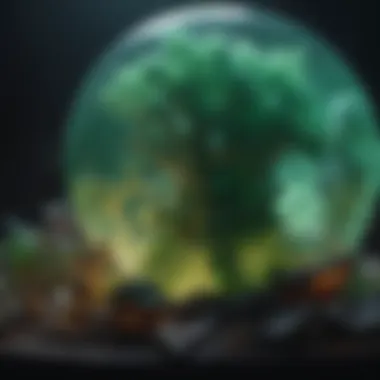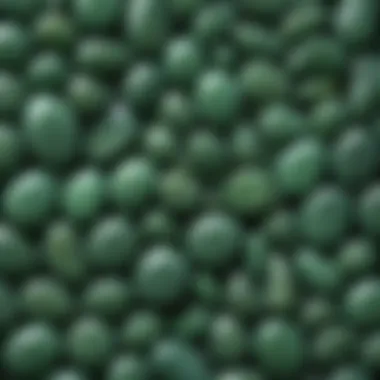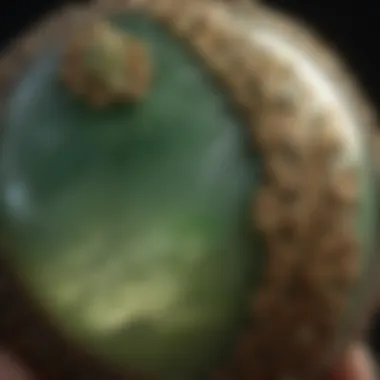Deciphering Authentic Jade from Fake: An In-Depth Analysis


Rock and Fossil Identification
When it comes to distinguishing real jade from fake jade, understanding rock and fossil identification is crucial. Authentic jade is a metamorphic rock characterized by its toughness and distinct textures. On the other hand, fake jade often exhibits smoother surfaces and lacks the intricate patterns found in genuine jade. To accurately differentiate between the two, collectors should pay close attention to key characteristics such as color, translucency, hardness, and specific gravity. Utilizing tools like magnifying glasses, UV lights, and scratch tests can aid in the identification process.
Collecting Tips and Techniques
For enthusiasts looking to add genuine jade pieces to their collection, following best practices for collecting is essential. Locating prime collecting sites known for authentic jade deposits is a strategic approach. Safely extracting specimens without causing damage requires precision and care. Proper excavation tools, such as chisels and brushes, should be utilized to carefully unearth jade without compromising its integrity.
Preservation and Display
Preserving and displaying jade specimens correctly is paramount to their longevity and aesthetic appeal. Techniques like using specialized storage containers to shield jade from light and moisture help maintain its original beauty. Creatively showcasing jade pieces can enhance their visual impact. Display ideas such as mounting in shadow boxes or incorporating them into jewelry designs can elevate the overall presentation.
Geological Insights
Delving into the geological insights surrounding jade reveals fascinating aspects about its formation and historical significance. Understanding the geological formations and processes that give rise to jade deposits sheds light on its rarity and value. Exploring notable discoveries in the field of jade mining unveils stories of exploration and uncovering breathtaking jade specimens. By grasping the geological context of jade, collectors can deepen their appreciation for this exceptional gemstone.
Introduction
In the realm of gemstones, jade stands out as a revered and highly sought-after mineral renowned for its exquisite beauty and cultural significance. This article delves deep into the intricate world of jade, specifically focusing on the crucial task of differentiating between authentic jade and the plethora of counterfeit versions flooding the market. By carefully examining the key characteristics that define genuine jade and unveiling the telltale signs that betray fake replicas, readers will be equipped with invaluable knowledge to navigate the nuanced landscape of jade identification.
Understanding the Significance of Jade
Jade holds a central place in numerous cultures worldwide, revered for its spiritual significance, exceptional beauty, and purported healing properties. The allure of jade transcends mere aesthetics; it symbolizes purity, longevity, and good fortune in various traditions. Understanding the profound significance attributed to jade across different societies provides a compelling backdrop to the necessity of ensuring the integrity and authenticity of this precious stone.
Importance of Authenticity in Jade
The authenticity of jade carries profound implications for both enthusiasts and collectors. Authenticity ensures not only the intrinsic value of the stone but also upholds its cultural and historical significance. Genuine jade represents a tangible link to ancient traditions and artisanal craftsmanship, making it a valuable heritage to preserve and protect. In a market saturated with counterfeit versions, the importance of discerning authenticity becomes paramount to uphold the integrity and true essence of jade.
Physical Characteristics of Real Jade
The section on the Physical Characteristics of Real Jade within this comprehensive guide plays a crucial role in educating readers on the intricate details that distinguish genuine jade from its counterfeit counterparts. Understanding the physical attributes of real jade is fundamental to making informed purchasing decisions and safeguarding against deceptive practices in the market. By delving into the tactile nuances, color spectrum, translucency, and clarity of jade, readers will gain a profound appreciation for the authenticity of this prized gemstone.


Texture and Feel
Delving into the texture and feel of jade is a sensory experience unlike any other. Genuine jade exudes a cool, smooth texture that is often described as
Testing Methods for Authenticity
In the realm of distinguishing real jade from fake jade, testing methods for authenticity play a pivotal role. Ensuring the genuineness of jade pieces is essential for collectors and enthusiasts alike. By utilizing specific techniques and tools, individuals can verify the authenticity of their jade items with precision and confidence. Exploring the texture, color, and translucency is crucial in conducting these tests. These methods serve as reliable indicators of a jade piece's authenticity, helping to separate genuine jade from imitations or synthetics. Examining jade through various testing methods enhances the overall understanding and appreciation of this revered gemstone.
Scratch Test
The scratch test is a fundamental method used to determine the hardness of jade. By carefully scratching the surface of the jade piece with different materials of known hardness, such as steel or quartz, collectors can assess the stone's resistance to abrasion. Genuine jade, known for its toughness and durability, will typically not scratch easily, maintaining its integrity even when subjected to significant pressure. This test provides valuable insights into the hardness of the jade, helping to differentiate between authentic jade and counterfeits or softer stones that may mimic its appearance.
Density and Hardness
Exploring the density and hardness of jade is another essential aspect of authenticity testing. Genuine jade exhibits a specific gravity that distinguishes it from other materials attempting to replicate its appearance. By measuring the stone's density and assessing its hardness through standardized scales like Mohs, collectors can gauge the authenticity of their jade pieces accurately. Understanding the unique physical properties of jade, including its density and hardness, offers a scientific approach to authenticity testing that adds credibility to the evaluation process.
Visual Inspection
In addition to tactile and scientific tests, visual inspection serves as a crucial component of authenticity assessment for jade. Examining the color consistency, translucency levels, and overall appearance of the jade piece can reveal important clues regarding its authenticity. Genuine jade often displays specific color variations and internal structures that set it apart from synthetic or dyed counterparts. Visual inspection, when combined with other testing methods, provides a comprehensive evaluation of the jade's authenticity, empowering collectors to make informed decisions about their acquisitions.
Common Misconceptions about Jade
In the realm of jade authenticity, there exist several common misconceptions that often lead buyers astray. Understanding and debunking these myths is crucial in the pursuit of genuine jade. One prevalent falsehood is the belief that dyed jade is of the same value as natural jade. Contrary to this misconception, dyeing jade alters its intrinsic properties, diminishing both its quality and worth. By shedding light on this misconception, buyers can avoid falling prey to misleading marketing tactics.
Another misconception pertains to the treatment of jade. Some falsely assume that treated jade is on par with untreated jade in terms of authenticity and value. The reality is that treated jade undergoes processes that enhance its appearance but do not necessarily reflect its true nature. Unveiling this myth is essential for buyers to make informed decisions and procure genuine jade pieces. Moreover, the misconception that synthetic jade is equivalent to natural jade often clouds buyers' judgment. Synthetic jade lacks the natural mineral composition and energy of authentic jade, rendering it significantly different in both quality and value.
Dyeing and Treatment
One common method used to deceive consumers is dyeing. Manufacturers often apply artificial colorants to jade to enhance its appearance or mimic the hues of high-grade jade. Dyeing can camouflage imperfections or low-quality jade, making it challenging for buyers to discern between natural and dyed jade. This practice compromises the integrity of the stone and misleads unsuspecting buyers. Buyers must be cautious when examining jade pieces with vivid or unnatural colors, as these may indicate dyeing.
Identifying Synthetic Jade


Discerning synthetic jade from its natural counterpart requires a keen eye for detail. Synthetic jade, such as glass or plastic imitations, lacks the authentic depth and translucency characteristic of genuine jade. Unlike genuine jade, synthetic versions often feel lighter and warmer to the touch. Additionally, synthetic jade may exhibit uniform coloration or an artificial-looking luster. By familiarizing themselves with the distinct qualities of synthetic jade, buyers can avoid purchasing counterfeit pieces and instead invest in authentic treasures.
Tips for Purchasing Authentic Jade
When it comes to purchasing authentic jade, there are essential considerations that must not be overlooked. Understanding the nuances of real jade is crucial in making informed purchasing decisions. In this section of the article, we will delve into the significance of acquiring authentic jade and explore the specific elements that play a key role in ensuring the purchase of genuine jade.
Trusted Sources
One of the most critical aspects of purchasing authentic jade is sourcing it from reliable and reputable sources. Trusted sources typically have a track record of selling genuine jade products and are known for their expertise in the field. When looking for authentic jade, it is essential to research and identify established sellers who have a reputation for dealing with genuine jade.
Certifications and Appraisals
Certifications and appraisals add an extra layer of assurance when purchasing jade. These documents authenticate the quality and authenticity of the jade, providing buyers with peace of mind regarding their purchase. It is advisable to look for certificates from reputable gemological institutes or expert appraisers to validate the jade's authenticity.
Price Considerations
Price can often be an indicator of jade authenticity, as genuine jade typically commands a higher price due to its rarity and desirability. However, it is essential not to rely solely on price when determining the authenticity of jade, as some counterfeit products may be priced high to deceive buyers. Understanding the market value of jade and comparing prices from different sellers can give valuable insights into the authenticity of the jade being offered.
Real Jade vs. Fake Jade: Visual Guide
In the realm of distinguishing real jade from fake jade, the visual guide becomes an indispensable tool for enthusiasts and collectors alike. This segment serves as a crucial component within the comprehensive guide, offering a practical and insightful approach to differentiating between genuine jade and its counterfeit counterparts. By providing a direct comparison between authentic and fake jade, readers gain a visual understanding of key differences, aiding in their quest to make informed decisions when acquiring jade artifacts.
Side-by-Side Comparison
Differences in Texture
Exploring the intricate world of texture within jade specimens is fundamental to the identification process. Texture serves as a pivotal aspect in differentiating between real jade and its fraudulent imitations. The texture of genuine jade boasts a unique smoothness and coolness to the touch, emanating a sense of natural elegance and authenticity. This characteristic adds a layer of depth to the overall visual and tactile experience, setting it apart from counterfeit jade pieces that often lack the genuine jade's distinctive texture. Understanding the nuances of texture enhances one's ability to scrutinize jade items effectively, enabling enthusiasts to elevate their collection with true treasures.
Color Discrepancies
The nuanced play of color in jade reveals profound insights into its authenticity. Color discrepancies present a crucial point of comparison between real and fake jade specimens. Authentic jade exhibits a spectrum of colors ranging from vibrant greens to subtle whites, each hue blending harmoniously to create a mesmerizing visual appeal. In contrast, fake jade often falls short in replicating the authentic color variations, displaying unnatural or inconsistent coloring patterns. By honing in on these color differences, collectors sharpen their discernment skills, thereby fortifying their capacity to detect counterfeit jade with accuracy.


Clarity Variations
Delving into the realm of clarity offers a comprehensive view of jade's intrinsic qualities. Clarity variations represent a key indicator when distinguishing between real and fake jade pieces. Genuine jade exudes a captivating clarity, allowing light to penetrate its surface and illuminate its inner beauty. This clarity reflects the stone's purity and authenticity, creating an enchanting visual allure. Conversely, counterfeit jade tends to lack the same level of clarity, appearing murky or opaque due to inferior craftsmanship or substandard materials. By recognizing these clarity nuances, individuals can safeguard themselves against purchasing counterfeit jade, ensuring that their collections remain adorned with genuine and exquisite pieces.
Identifying Fake Jade
Unveiling the telltale signs of fake jade requires a keen eye for detail and an understanding of the subtle cues that betray authenticity. This section serves as a critical juncture in the journey of discerning collectors, equipping them with the knowledge needed to identify counterfeit jade with confidence and precision.
Inconsistencies in Color
The presence of inconsistencies in color serves as a pivotal red flag when assessing the authenticity of jade. Genuine jade exudes a consistent and harmonious color palette, reflecting the unique mineral composition and formation process that bestows it with unparalleled beauty. In contrast, fake jade often showcases erratic color distributions or unnatural tonal shifts, signifying a lack of integrity in the material used. By pinpointing these color irregularities, collectors can swiftly differentiate between real jade and its counterfeit counterparts, ensuring that their acquisitions uphold the standards of authenticity and quality.
Unnatural Texture
The texture of jade unveils a wealth of information regarding its provenance and quality. Unnatural textures present a distinct marker of fake jade, denoting inferior craftsmanship and synthetic compositions. Authentic jade boasts a refined and organic texture, harkening back to its geological origins and natural formation processes. Conversely, counterfeit jade exhibits a contrived or artificial texture, lacking the genuine feel and opulence that define real jade specimens. By evaluating these textural discrepancies, collectors arm themselves with the knowledge necessary to discern between genuine jade treasures and counterfeit imitations, safeguarding the integrity of their collection.
Lack of Depth in Appearance
The depth of appearance within jade artifacts encapsulates a sense of allure and mystique that distinguishes genuine pieces from their fake counterparts. A lack of depth in appearance is a common trait observed in counterfeit jade, reflecting a superficiality that falls short of the profound qualities inherent in authentic jade specimens. Genuine jade items possess a mesmerizing depth that beckons the viewer to explore its layers and intricacies, evoking a sense of awe and admiration. In contrast, fake jade often appears flat or one-dimensional, lacking the multidimensional allure that characterizes true jade treasures. By recognizing these depth-related discrepancies, collectors elevate their ability to discern between authentic and counterfeit jade, ensuring that their collections are filled with genuine and captivating pieces.
Conclusion
In the realm of distinguishing real jade from fake jade, the conclusion of this comprehensive guide serves as the proverbial bow tying together all the crucial elements discussed throughout the article. Understanding the significance of authenticity in jade is paramount, especially for collectors, jewelers, and enthusiasts seeking genuine pieces of this prized gemstone. Through a meticulous exploration of physical characteristics, testing methods, common misconceptions, tips for purchasing, and a visual guide comparing real and fake jade, readers are equipped with a comprehensive toolkit to discern the authenticity of jade specimens.
The importance of this conclusion lies in its ability to offer a cohesive summary, reinforcing the key points that differentiate real jade from counterfeit versions. By synthesizing the information presented, readers are left with a concise yet thorough understanding of the nuances that separate authentic jade from its imitations. This conclusive section acts as a guidepost, directing individuals towards making informed decisions when acquiring jade pieces, ensuring they invest in genuine items that hold both monetary and sentimental value.
Summary of Key Points
Throughout this article, the key points elucidated have shed light on the intricate characteristics that set real jade apart from fake jade. From understanding the significance and importance of authenticity in jade to delving into the physical attributes like texture, color, and translucency, readers have been granted a detailed insight into the multifaceted world of jade appraisal.
Testing methods such as the scratch test, density, and visual inspections have been outlined to aid readers in conducting their assessments, while debunking common misconceptions around treatments and synthetic jade production. Furthermore, tips for purchasing authentic jade, emphasizing the need for trusted sources, certifications, and pricing considerations, have empowered readers to navigate the market landscape with confidence.
Final Thoughts on Authenticity
As we conclude this in-depth journey of distinguishing real jade from fake jade, it is apparent that authenticity is the cornerstone of jade appreciation and acquisition. In a market saturated with imitations and counterfeit pieces, the quest for genuine jade becomes both a pursuit of value and a testament to the legacy of this revered gemstone.
Final thoughts on authenticity underscore the importance of due diligence and vigilance when engaging with jade items. By honing the ability to discern between authentic and fake jade, collectors not only safeguard themselves against fraudulent practices but also preserve the integrity and allure of genuine jade pieces. Authenticity transcends monetary worth, encapsulating the historical, cultural, and emotional significance that genuine jade embodies, making it a cherished possession for generations to come.







